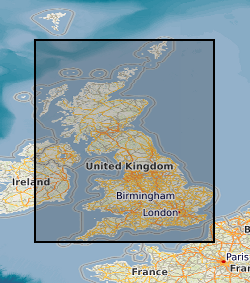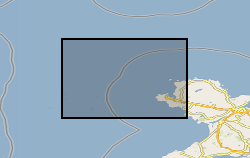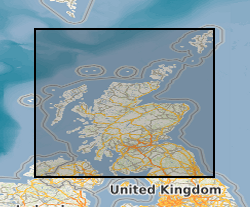ESRI Shapefiles
Type of resources
Topics
Keywords
Contact for the resource
Provided by
Years
Formats
Representation types
Update frequencies
Scale
-

Data identifying landscape areas (shown as polygons) attributed with geological descriptions and thermal properties of geological materials. The scale of the data is 1:250 000 scale for the Thermal Properties V1 dataset. Onshore coverage is for Great Britain and the Isle of Man. This dataset shows thermal properties relating to bedrock beneath our feet. The information can be used to assess the potential for closed and open loop ground source heat pumps across, or deeper geothermal assessments, across the United Kingdom. The attribution and spatial data underpinning the model are that which is described and shown by Rollin (1987) and Gale (2004, 2005). The information is presented vector-based, irregular polygon coverage at 1:250 000 scale Each polygon is attributed with a range of geological properties including modelled values for Thermal conductivity, thermal diffusivity, specific heat capacity and density. The data are available in vector format (containing the geometry of each feature linked to a database record describing their attributes) as ESRI shapefiles and are available under BGS data licence.
-

Data identifying landscape areas (shown as polygons) attributed with geological names and rock type descriptions. The data is presented at 1:50 000 scale. Onshore coverage is provided for England, Scotland, Wales and the Isle of Man. Approximately 99% coverage is available and BGS is committed to completing the coverage, and ongoing updates as part of its ongoing national survey. Bedrock geology describes the main mass of solid rocks forming the earth's crust. Bedrock is present everywhere, whether exposed at surface in outcrops or concealed beneath superficial deposits or water bodies. The bedrock geology of Great Britain is very diverse and includes three broad classes based on their mode of origin: igneous, metamorphic, and sedimentary. The data includes attribution to identify each rock type (in varying levels of detail) as described in the BGS Rock Classification Scheme (volumes 1-3). The bedrock has formed over long periods of geological time, from the Archean eon some 4000 million years ago, to the relatively young Pliocene, 5.33 million years ago. The age of the rocks is identified in the data through their BGS lexicon name (published for each deposit at the time of the original survey or subsequent digital data creation). For stratified rocks i.e., arranged in sequence, this will usually be of a lithostratigraphic type. Other rock types for example intrusive igneous bodies will be of a lithodemic type. More information on the formal naming of UK rocks is available in the BGS Lexicon of Named Rock Units. Geological names are based on the lithostratigraphic or lithodemic hierarchy. The lithostratigraphic scheme arranges rock bodies into units based on rock-type and geological time of formation. Where rock-types do not fit into the lithostratigraphic scheme, for example intrusive, deformed rocks subjected to heat and pressure resulting in new or changed rock types; then their classification is based on their rock-type or lithological composition. This assesses visible features such as texture, structure, mineralogy. The data are available in vector format (containing the geometry of each feature linked to a database record describing their attributes) as ESRI shapefiles and are available under BGS data licence.
-

Data identifying landscape areas (shown as polygons) attributed with type of mass movement e.g. landslip. The data is presented at 1:50 000 scale. Onshore coverage is provided for England, Scotland, Wales and the Isle of Man. Approximately 99% coverage is available and BGS is committed to completing the coverage, and ongoing updates as part of its ongoing national survey. Mass movement describes areas where deposits have moved down slope under gravity to form landslips. These landslips can affect bedrock, superficial or artificial ground. Mass movement deposits are described in the BGS Rock Classification Scheme Volume 4. However, the data also includes foundered strata, where ground has collapsed due to subsidence (this is not described in the Rock Classification Scheme). Caution should be exercised with this data; historically BGS has not always recorded mass movement events and due to the dynamic nature of occurrence significant changes may have occurred since the data was released. The data are available in vector format (containing the geometry of each feature linked to a database record describing their attributes) as ESRI shapefiles and are available under BGS data licence.
-

BGS GeoSure identifies, at 1:50 000 scale, areas of susceptibility and considers the following specific hazard processes that can occur in Great Britain: 1. Shrink–Swell: Swelling clays change in volume due to changes in water content; this can lead to movements (up or down) in the upper two metres of the ground, which may affect property foundations. 2. Landslides (Slope Instability): Slope instability occurs when particular slope characteristics combine to make the slope unstable. Downslope movement of materials (landslide) may cause damage to foundations, services or impact damage to buildings. 3. Soluble Rocks (Dissolution): Ground dissolution occurs when certain types of rocks, containing layers of soluble material, get wet and the soluble material dissolves. This can cause underground cavities to develop. These cavities reduce support to the ground above and can lead to a collapse of overlying rocks. 4. Compressible Ground: Some types of ground may contain layers of very weak materials such as peat or some types of poorly structured clays. These may compress if loaded by overlying structures, or if the groundwater level changes. This compression may result in depression of the ground surface, potentially disturbing foundations and services. 5. Collapsible Deposits: Some soils may collapse when a load (building or road traffic) is placed on them, especially if they become saturated. Such collapse may cause damage to overlying property or services. 6. Running Sand: Some rocks and soils can contain loosely packed sandy layers that can become fluidised by water flowing through them. Such sands can ‘run’ (flow), potentially removing support from overlying buildings and causing damage.
-

Data identifying landscape areas (shown as polygons) attributed with geological names and rock type descriptions. The data is presented at 1:50 000 scale. Onshore coverage is provided for England, Scotland, Wales and the Isle of Man. Approximately 99% coverage is available and BGS is committed to completing the coverage, and ongoing updates as part of its ongoing national survey. Superficial deposits are the youngest geological deposits formed during the most recent period of geological time, the Quaternary, which extends back about 2.58 million years from the present. They lie on top of older deposits or rocks referred to as bedrock. Superficial deposits were laid down by various natural processes such as action by ice, water, wind, and weathering. As such, the deposits are denoted by their BGS lexicon name, which classifies them the basis of their mode of origin (lithogenesis) with names such as, 'glacial deposits', 'river terrace deposits' or 'blown sand'; or the basis of their composition such as 'peat'. Most of these superficial deposits are unconsolidated sediments such as gravel, sand, silt, and clay. The digital data includes attribution to identify each deposit type (in varying levels of detail) as described in the BGS Rock Classification Scheme (volume 4). The data are available in vector format (containing the geometry of each feature linked to a database record describing their attributes) as ESRI shapefiles and are available under BGS data licence.
-

The BGS Seabed Geology 10k: Anglesey digital map portrays the distribution of the different types of bedrock and sediments that are interpreted to represent the dominant geology within to the top 1-2 metres of the seabed to the north-west of Anglesey, at a scale of 1:10 000. It also includes the distribution of the main seabed morphological and geomorphological features (e.g. drumlins, sandwaves) and the principal structural features observed at rockhead (fractures). This digital map is the result of the interpretation of two high-resolution, multibeam echo-sounder (MBES) bathymetry datasets: (i) the Off Skerries HI1420 survey, collected by Net Survey in 2013 as part of the Civil Hydrography Programme (CHP) surveys managed by the Maritime and Coastguard Agency (MCA) for the UK Hydrographic Office; and (ii) the North St George’s Channel candidate Marine Conservation Zone (rMCZ) survey, collected jointly by JNCC and Cefas in 2012 for the Department for Environment, Food and Rural Affairs (Defra). MBES backscatter, physical samples (e.g. grabs, cores, and boreholes), academic papers and previous BGS geological interpretations at broader scales (250k and 50k scales) were used to further inform this geological interpretation. The bedrock is divided into three units: (i) Neoproterozoic to Palaeozoic age metamudstones and metasandstones of the Monian Supergroup; (ii) undifferentiated Lower Palaeozoic age rocks (mudstone, volcaniclastics, siltstone, slate); and (iii) limestone and sandstone of the Carboniferous Limestone Supergroup. The superficial deposits are composed of various types of glacial sediments (e.g. glacial till and morainic deposits) that were deposited underneath and around the margins of the last British-Irish Ice Sheet in the area, and also more recently deposited marine sediments.
-

The BGS Hydrogeological Maps of Scotland data product is comprised of three datasets: Bedrock Aquifer Productivity (Scotland); Superficial Aquifer Productivity (Scotland); and Groundwater Vulnerability (Scotland). Aquifer productivity is a measure of the potential of aquifers to sustain a borehole water supply. The Aquifer Productivity (Scotland) datasets indicate the location and productivity of bedrock and superficial aquifers across Scotland, and their groundwater flow characteristics. The Groundwater Vulnerability (Scotland) dataset shows the relative vulnerability of groundwater to contamination across Scotland. The BGS Hydrogeological Maps of Scotland data product is developed as a tool to support groundwater resource management. It may be useful to anyone interested in learning more about, assessing or managing groundwater resources across Scotland. The datasets within the product are delivered at 1: 100 000 scale.
 NERC Data Catalogue Service
NERC Data Catalogue Service